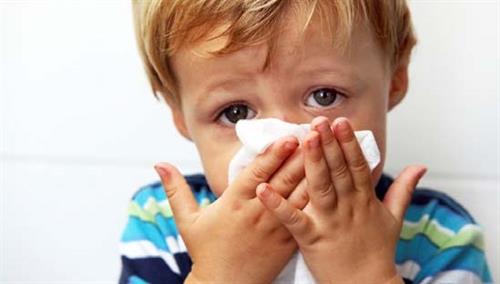 Everywhere & Everyone IPM Integrated Pest Management Newsletter – February 2018
Everywhere & Everyone IPM Integrated Pest Management Newsletter – February 2018
View this newsletter as a PDF.
Editor: Shujuan (Lucy) Li, lisj@cals.arizona.edu
Submitted by: Dawn H. Gouge (public health entomologist, Department of Entomology) and
Channah Rock (environmental microbiologist, Department of Soil, Water
and Environmental Science)
 The Centers for Disease Control and Prevention (CDC) report that although we are only about halfway through flu season, the influenza virus is already widespread in 48 states, and tragicaly at least 53 children have died.
The Centers for Disease Control and Prevention (CDC) report that although we are only about halfway through flu season, the influenza virus is already widespread in 48 states, and tragicaly at least 53 children have died.
It’s well known that the severity and length of a flu season varies every year, and the CDC say that your best shot at avoiding illness is to get a flu shot.
Current U.S. statistics indicate that the flu vaccine is reducing the risk of illness by 40 to 60 % (CDC), and even if you do get the flu after receiving a flu shot, the illness may be milder.
Flu comes every year, but the health impacts differ depending on when, and which strains start circulating. In recent years, flu related deaths have ranged from a low of about 3,000 to a high of about 49,000 people per year. Hospitalizations also range between 140,000 and 710,000 annually (CDC).
Flu is a serious disease and can be life threatening.
Any person experiencing chest pain or breathing complications should seek immediate medical assistance.
Information about flu can be found on the CDC website https://www.cdc.gov/flu/index.htm, and our previous newsletter covered some flu basics https://cals.arizona.edu/apmc/docs/2018JanuaryAZschoolandhomeIPMNewletter.pdf.
The CDC recommends that people who are very sick or who are at high risk of serious flu complications, and get flu symptoms be treated with antiviral drugs as soon as possible. Guidance to determine if you are at high risk of complications can be found at: https://www.cdc.gov/flu/about/disease/high_risk.htm.

Flu viruses change constantly and several strains circulate each year, which partially explains why vaccines never provide 100 % protection.
People who are already ill are usually advised to recover before getting the vaccination, but it is wise to confirm with your primary care physician to determine if the flu vaccine is right for you.
People who have previously had a severe allergic reaction to the influenza vaccine or any of its ingredients should not be vaccinated.
Humans are not the only creatures suffering from influenza this year, canine influenza has been reported in 46 states.
The American Veterinary Medical Association (AVMA) reports that dog flu is very infectious to other canines, and nearly all dogs exposed will become infected, with about 80% becoming ill. Symptoms are similar to those seen in humans and include fatigue, cough, sneezing, and a runny nose. Dog flu is generally a mild illness but can be lethal for some dogs.
 According to CDC two common strains of influenza A cause the flu in dogs: H3N2 and H3N8. You may be aware that the most common human flu strain circulating this year is also H3N2. However, the human adapted H3N2 and the canine adapted H3N2 are not the same. There are no known cases of humans catching the flu virus from their dogs.
According to CDC two common strains of influenza A cause the flu in dogs: H3N2 and H3N8. You may be aware that the most common human flu strain circulating this year is also H3N2. However, the human adapted H3N2 and the canine adapted H3N2 are not the same. There are no known cases of humans catching the flu virus from their dogs.
There have been documented cases of flu viruses that transfer between humans, pigs, and birds, but as of this writing, there have been no scientific studies that show influenza transferring between people and our canine best friends.
The AVMA recommends vaccinating dogs against influenza if your dog routinely interacts with many other dogs, in kennels, canine daycare, or in dog parks.
You cannot infect your cat or dog with human flu.
You cannot catch flu from your cat or dog.
- Avoid close contact with people who are sick. When you are sick, keep your distance from others and consider wearing a mask when contact is required.
- Stay home from work, school, and errands when you are sick. This will help prevent spreading your illness to others.
- Clean your hands by washing often and thoroughly with soap and warm water.
- Avoid touching your face, especially eyes, nose or mouth.
- Clean and disinfect surfaces and objects. Flu viruses and other germs spread when a person touches a surface or object that is contaminated with germs and then touches their eyes, nose, or mouth.
Here are five important things to know as you combat the flu virus.

 - Follow standard institutional procedures for handling waste, which may include wearing gloves. Place no-touch wastebaskets where they are easy to use. Avoid touching used tissues when emptying wastebaskets, or wear gloves if tissues must be handled. Wash your hands with soap and water after processing waste and dispose of gloves.
- Follow standard institutional procedures for handling waste, which may include wearing gloves. Place no-touch wastebaskets where they are easy to use. Avoid touching used tissues when emptying wastebaskets, or wear gloves if tissues must be handled. Wash your hands with soap and water after processing waste and dispose of gloves.
Citations
Antimicrobial products http://npic.orst.edu/factsheets/antimicrobials.html
Canine Influenza. American Veterinary Medical Association
https://www.avma.org/KB/Resources/Reference/Pages/Canine-Influenza-Backgrounder.aspx
Key Facts about Canine Influenza (Dog Flu). Centers for Disease Control and Prevention https://www.cdc.gov/flu/canineflu/keyfacts.htm
Centers for Disease Control and Prevention. https://www.cdc.gov/flu/about/disease/us_flu-related_deaths.htm